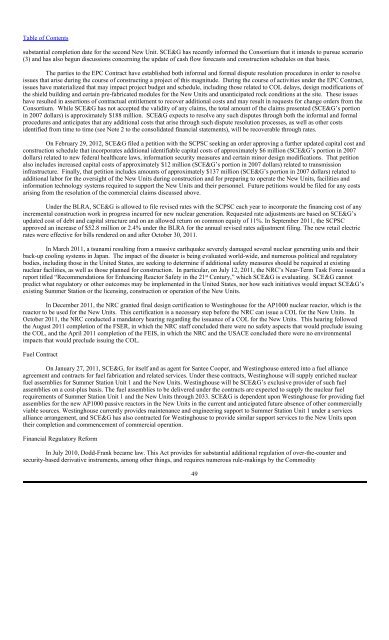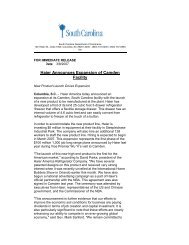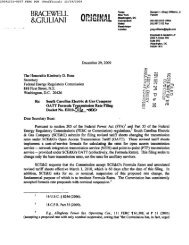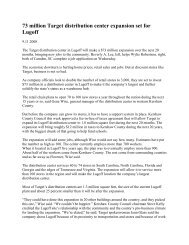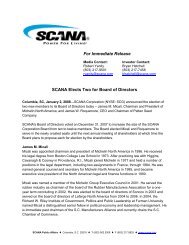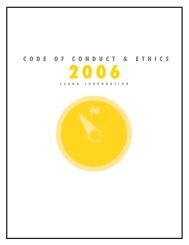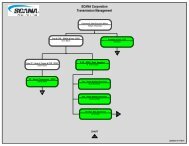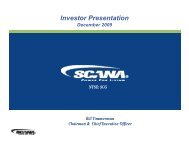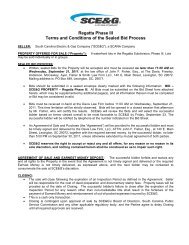10-K - SCANA Corporation
10-K - SCANA Corporation
10-K - SCANA Corporation
You also want an ePaper? Increase the reach of your titles
YUMPU automatically turns print PDFs into web optimized ePapers that Google loves.
Table of Contents<br />
substantial completion date for the second New Unit. SCE&G has recently informed the Consortium that it intends to pursue scenario<br />
(3) and has also begun discussions concerning the update of cash flow forecasts and construction schedules on that basis.<br />
The parties to the EPC Contract have established both informal and formal dispute resolution procedures in order to resolve<br />
issues that arise during the course of constructing a project of this magnitude. During the course of activities under the EPC Contract,<br />
issues have materialized that may impact project budget and schedule, including those related to COL delays, design modifications of<br />
the shield building and certain pre-fabricated modules for the New Units and unanticipated rock conditions at the site. These issues<br />
have resulted in assertions of contractual entitlement to recover additional costs and may result in requests for change orders from the<br />
Consortium. While SCE&G has not accepted the validity of any claims, the total amount of the claims presented (SCE&G’s portion<br />
in 2007 dollars) is approximately $188 million. SCE&G expects to resolve any such disputes through both the informal and formal<br />
procedures and anticipates that any additional costs that arise through such dispute resolution processes, as well as other costs<br />
identified from time to time (see Note 2 to the consolidated financial statements), will be recoverable through rates.<br />
On February 29, 2012, SCE&G filed a petition with the SCPSC seeking an order approving a further updated capital cost and<br />
construction schedule that incorporates additional identifiable capital costs of approximately $6 million (SCE&G’s portion in 2007<br />
dollars) related to new federal healthcare laws, information security measures and certain minor design modifications. That petition<br />
also includes increased capital costs of approximately $12 million (SCE&G’s portion in 2007 dollars) related to transmission<br />
infrastructure. Finally, that petition includes amounts of approximately $137 million (SCE&G’s portion in 2007 dollars) related to<br />
additional labor for the oversight of the New Units during construction and for preparing to operate the New Units, facilities and<br />
information technology systems required to support the New Units and their personnel. Future petitions would be filed for any costs<br />
arising from the resolution of the commercial claims discussed above.<br />
Under the BLRA, SCE&G is allowed to file revised rates with the SCPSC each year to incorporate the financing cost of any<br />
incremental construction work in progress incurred for new nuclear generation. Requested rate adjustments are based on SCE&G’s<br />
updated cost of debt and capital structure and on an allowed return on common equity of 11%. In September 2011, the SCPSC<br />
approved an increase of $52.8 million or 2.4% under the BLRA for the annual revised rates adjustment filing. The new retail electric<br />
rates were effective for bills rendered on and after October 30, 2011.<br />
In March 2011, a tsunami resulting from a massive earthquake severely damaged several nuclear generating units and their<br />
back-up cooling systems in Japan. The impact of the disaster is being evaluated world-wide, and numerous political and regulatory<br />
bodies, including those in the United States, are seeking to determine if additional safety measures should be required at existing<br />
nuclear facilities, as well as those planned for construction. In particular, on July 12, 2011, the NRC’s Near-Term Task Force issued a<br />
report titled “Recommendations for Enhancing Reactor Safety in the 21<br />
st<br />
Century,” which SCE&G is evaluating. SCE&G cannot<br />
predict what regulatory or other outcomes may be implemented in the United States, nor how such initiatives would impact SCE&G’s<br />
existing Summer Station or the licensing, construction or operation of the New Units.<br />
In December 2011, the NRC granted final design certification to Westinghouse for the AP<strong>10</strong>00 nuclear reactor, which is the<br />
reactor to be used for the New Units. This certification is a necessary step before the NRC can issue a COL for the New Units. In<br />
October 2011, the NRC conducted a mandatory hearing regarding the issuance of a COL for the New Units. This hearing followed<br />
the August 2011 completion of the FSER, in which the NRC staff concluded there were no safety aspects that would preclude issuing<br />
the COL, and the April 2011 completion of the FEIS, in which the NRC and the USACE concluded there were no environmental<br />
impacts that would preclude issuing the COL.<br />
Fuel Contract<br />
On January 27, 2011, SCE&G, for itself and as agent for Santee Cooper, and Westinghouse entered into a fuel alliance<br />
agreement and contracts for fuel fabrication and related services. Under these contracts, Westinghouse will supply enriched nuclear<br />
fuel assemblies for Summer Station Unit 1 and the New Units. Westinghouse will be SCE&G’s exclusive provider of such fuel<br />
assemblies on a cost-plus basis. The fuel assemblies to be delivered under the contracts are expected to supply the nuclear fuel<br />
requirements of Summer Station Unit 1 and the New Units through 2033. SCE&G is dependent upon Westinghouse for providing fuel<br />
assemblies for the new AP<strong>10</strong>00 passive reactors in the New Units in the current and anticipated future absence of other commercially<br />
viable sources. Westinghouse currently provides maintenance and engineering support to Summer Station Unit 1 under a services<br />
alliance arrangement, and SCE&G has also contracted for Westinghouse to provide similar support services to the New Units upon<br />
their completion and commencement of commercial operation.<br />
Financial Regulatory Reform<br />
In July 20<strong>10</strong>, Dodd-Frank became law. This Act provides for substantial additional regulation of over-the-counter and<br />
security-based derivative instruments, among other things, and requires numerous rule-makings by the Commodity<br />
49


